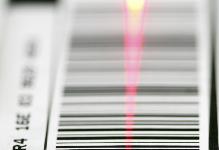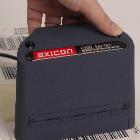 | |||||
 | |||||
| ||
 | |||||
 | |||||
Why Verify?
Complicated Structure: The readabilty of a barcode is highly dependant on the quality of the barcode. Even the simplest fault in the structure and quality of the barcode can render it unreadable and therefore useless, or worse cause the barcode to read as a different number, leading to incorrect stock levels and price charges.
Difficult to See: Although some faults are visible to the naked eye the nature of the barcode symbol dictates that the majority of problems will only be picked up using a highly accurate quality control unit (a barcode verifier).
Fines Imposed: If barcodes are destined for the consumer market it should also be pointed out that many Major Retailers throughout the world are imposing heavy fines on their suppliers for sub-standard barcodes.
What Does a Barcode Verifier Comprise?
Reading Head, Data Analyser, Display: A barcode verifier generally comprises a reading head, a data analyser and a display screen for the results.
Portable: Portable verifiers will consist of a reading head which is attached to a hand held enclosure that contains the controls and day screen.
PC-Based: Alternatively there are PC based units where the hardware will generally comprise a reading head and data analyser and then the controls and results are shown through the units software on your computer.
Verifier/Scanner Comparison: The verifier reading head must not be confused with a standard barcode scanner, they are two totally different pieces of hardware. A barcode scanner is merely trying to obtain a read from the barcode whereas a verifier is taking many accurate measurements from the barcode in order to provide data for the various quality control calculations.
The fact that a barcode can be read by a standard scanner is no guarantee that it is of acceptable quality. Scanners can take many thousands of scans per second and becuase of this it is impossible to know if the barcade might have scanned easily as the first few scanning beams crossed the barcode or whether it took many hundreds of scans before a decose was achieved. Also scanners vary greatly and what can be read by one cannot necessarily be read by another, which is why verification is essential to ensure the quality of your barcode.
What is CEN/ANSI/ISO?
Standards: Verification equipment is usually described as being of a certain standard, and this will dictate which quality control calculations it must perform. There are two main standards for verification, Traditional and CEN/ANSI/ISO.
Traditional: When barcode verifiers were first developed they only checked for a few main points which were relevant to the printing technologies of the time, Print Contrast Signal (PCS) and Bar Deviation being the main two. These verifiers are known as Traditional grade verifiers, but they are no longer regarded as acceptable instruments for quality control for many organisations.
CEN/ANSI/ISO: As printing technologies have developed new standards have been set up by the American National Standards Institute (ANSI) and the European Committee for Normalization (CEN), and more recently adopted by the International Standards Organisation (ISO). Verifiers adhering to these standards are known as CEN/ANSI/ISO grade verifiers.
Parameters: These new standards offer a far more comprehensive check on the quality of the barcodes, using seven main parameters:
+ Minimum Reflectance
+ Symbol Contrast
+ Minimum Edge Contrast
+ Modulation
+ Decodability
+ Defects
+ Decode
Gradings: This system uses a grading system of 4-0 (or A-D and F). Most Major Retailers expect codes to be of a grade C or higher, with the exception of codes printed directly on to corrugated which may be a grade D for Symbol Contrast and Defects but a grade C for other parameters. However some retailers are stricter and you should always check with your individual customers for their requirements.